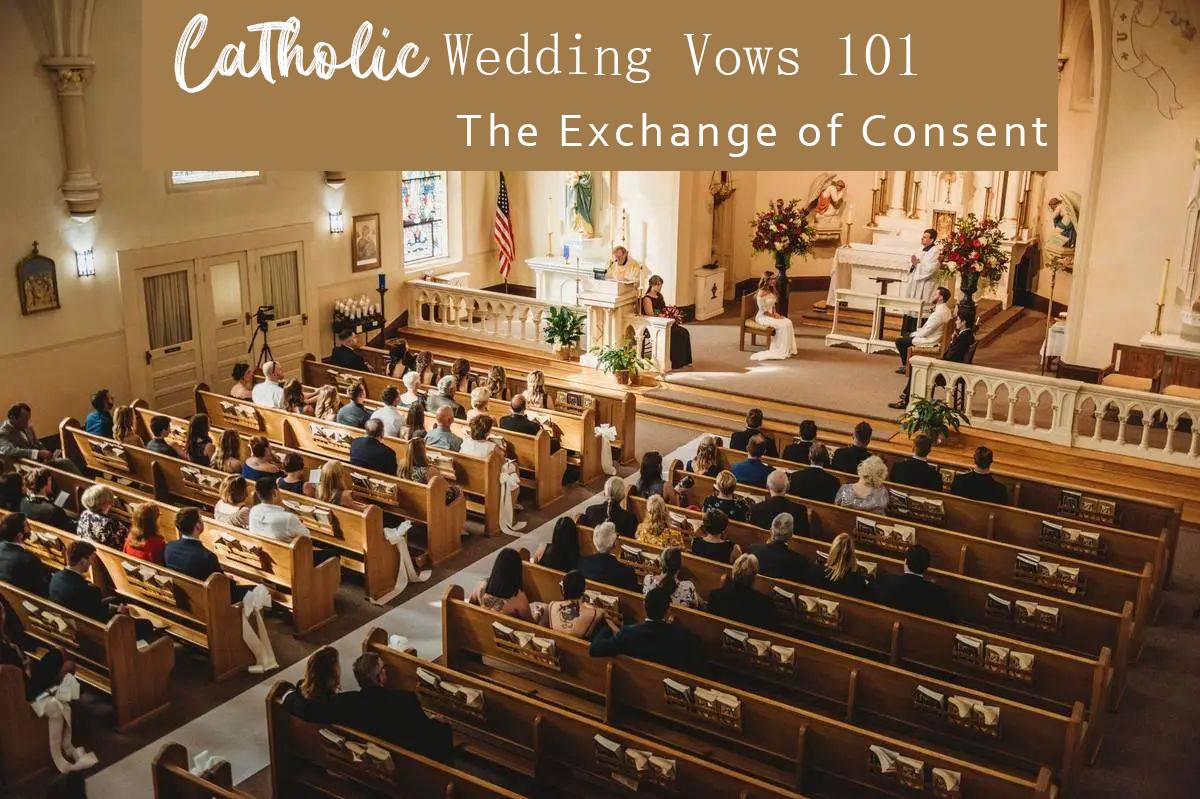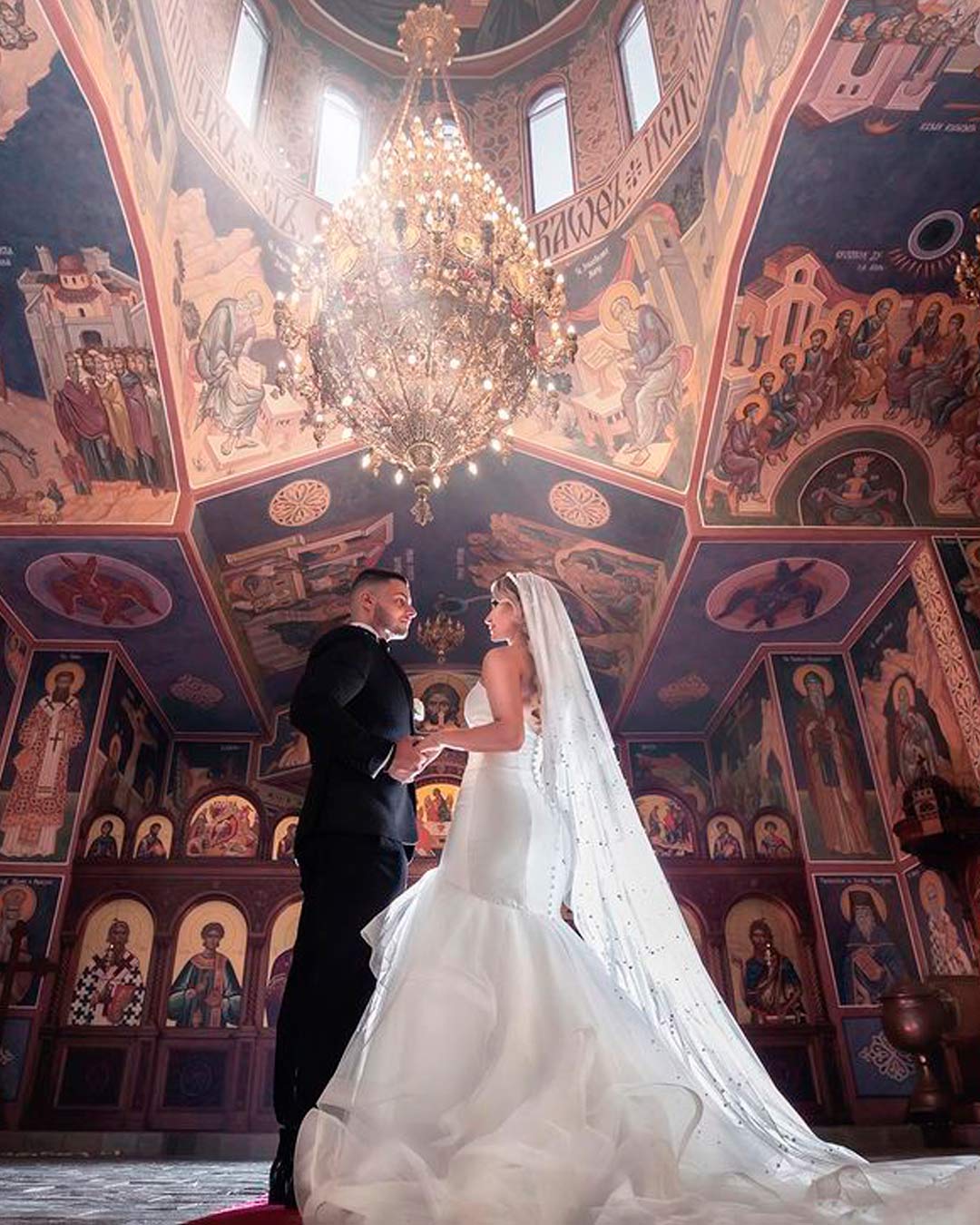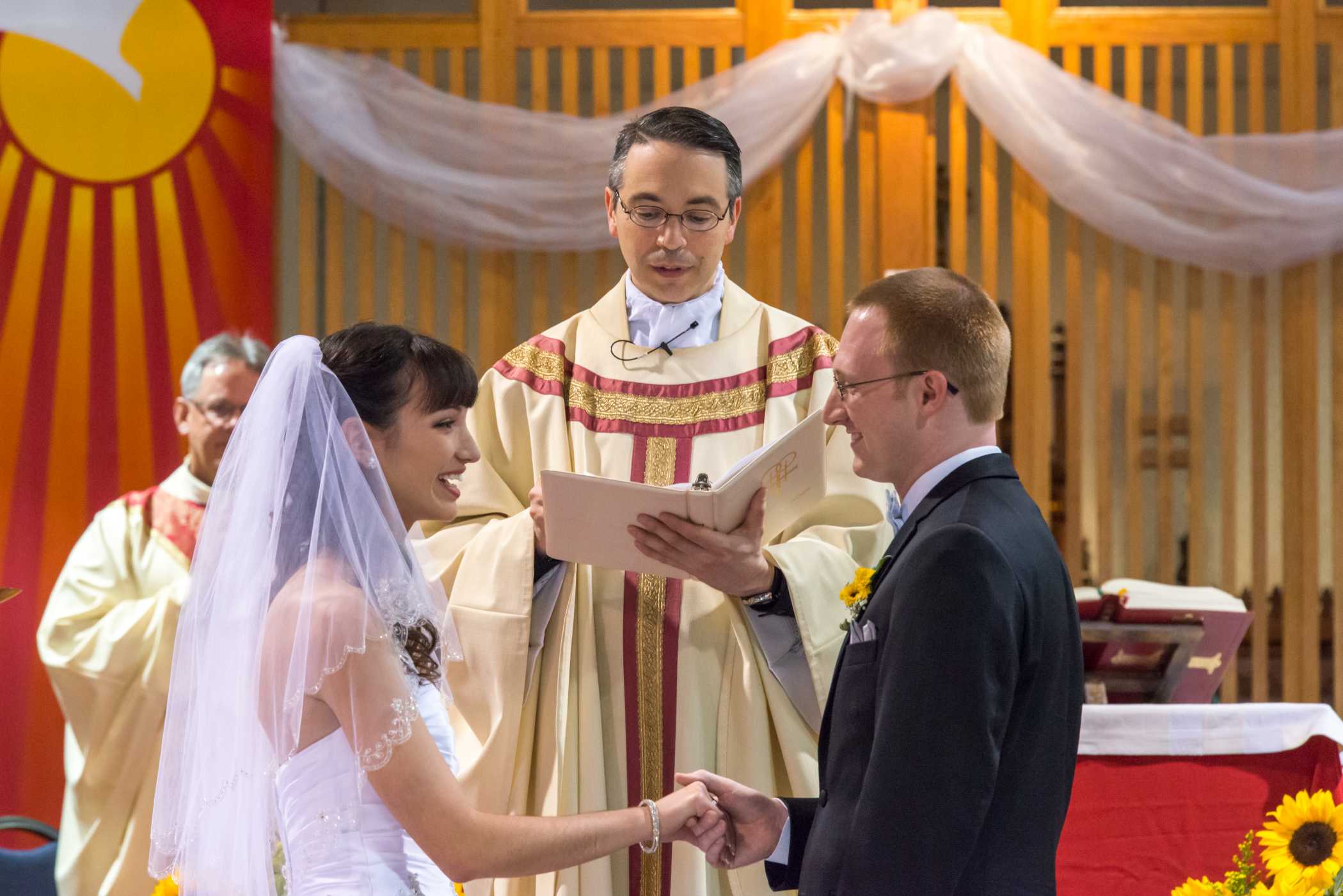The Exchange of Consent – Catholic Wedding Vows 101

Marriage vows are often called the marriage vows, and are the heart of the Catholic wedding ceremony. As the Catechism of the Catholic Church says, the consent exchanged between a bride and groom“is the indispensable element that ‘makes the marriage’” (no. 1626). There is no marriage without consent. The exchange of consent is part of every Catholic wedding ceremony, whether it takes place during Mass, without Mass, or between Catholics and unbaptized persons. Before the blessing and giving of rings, it takes place after the Questions Before Consent.
The words of consent provide rich reflection both for couples preparing for marriage and those married for years. Pope Francis wrote in Amoris Laetitia that the words of consent “cannot be reduced to the present; they involve a totality that includes the future: ‘until death do us part’” (no. 214). By promising in the presence of God and the Church to love each other faithfully for the rest of their lives, bride and groom form an unbreakable covenant.
If you’re in the throes of wedding planning and are at a loss for what those Catholic wedding vows should look like, read on.

Traditional Catholic Wedding Vows
Here are a number of guidelines surrounding traditional Catholic wedding vows. The main ones being the three questions couples are expected to respond to before they can take their vows. These questions are as follows.
“Have you come here freely and without reservation to give yourself to each other in marriage?”
“Will you honor each other as man and wife for the rest of your lives?”
and, “Will you accept children lovingly from God, and bring them up according to the law of Christ and his Church?”
After responding positively to these questions, then the couple can take their vows.
Catholic wedding vows samples:
“I, ___, take you, ___, for my lawful wife/husband, to have and to hold from this day forward, for better, for worse, for richer, for poorer, in sickness and health, until death does us part.”
Roman Catholic Wedding Vows
Not very different from any other Christian wedding ceremony, the Roman Catholic wedding vows come with similar values. The couple state that they are making this commitment to one another without any concerns or doubts. They also promise to build their family with Christian values. Lastly, they promise to love and honor each other for the rest of their lives. These wedding vows are included in every Roman Catholic wedding, regardless of the size of the event. Couples can add a few readings or words to each other to personalize their vows if needed. Just as long as they have the standard Roman Catholic wedding vows first.
Roman Catholic wedding vows samples:
“Before the presence of God, I choose you to be my partner for life. You have inspired me to be a better person. Your love has done for my life what I did not know was possible. We will go forth as one. We will blend our families to become one family. In return, I promise to love you, be faithful to you, respect you, and stand by your side. I promise to never put anyone before you. I promise to do this for the rest of my life.”

Wedding Priest Speech
The sermon itself, called The Order of Celebrating Matrimony, starts with the priest asking three questions. These are obligatory questions that the couple should answer. The Order of Celebrating Matrimony requires the couple to answer these questions for the wedding to take place:
“(Name) and (name), have you come here to enter into Marriage without coercion, freely and wholeheartedly?”
“Are you prepared, as you follow the path of Marriage, to love and honor each other for as long as you both shall live?”
“Are you prepared to accept children lovingly from God and to bring them up according to the law of Christ and his Church?”
If the bride and groom respond positively, the wedding sermon begins. Here’s the basic ceremony script:
- Greeting of the couple and congregation by the minister
- Opening prayer (six versions to choose from)
- The Liturgy of the Word
- The Celebration of Matrimony
- The Lord’s Prayer
- Optional: The Blessing and Placing of the Lazo or the Veil, a tradition important in Hispanic and Filipino families
- The Nuptial Blessing (three versions)
- Blessing of the newly married couple and the congregation
- Dismissal
- Recessional (a hymn could be sung, or instrumental music could be played)
After the ceremony, the witnesses ( the best man and maid of honor) and priest or deacon sign the Marriage record in the presence of the people.
Liturgy Of The Word
The Liturgy of the Word is one of the most important parts of the Catholic ceremony. It expresses “the importance of Christian Marriage in the history of salvation and the responsibilities and duties of Marriage to be attended to for the sanctification of the spouses and of their children.” (Order of Celebrating Matrimony, 35)
The Liturgy of the Word may include two or three readings and the Responsorial Psalm. Also, at least one of readings must speak of holy matrimony. Here’s the chance for the bride and groom to make their wedding more intimate. The Liturgy of the Word has multiple options to choose from. It is essential for the engaged couple to work together with the officiant (and perhaps the parish staff, as they participate in the musical selections).
Although the text of the vows cannot be changed, the couple still can choose certain texts of the wedding. Such parts as the Scripture readings, the Prayers of the Faithful, musical selections etc can vary to make the wedding more personalized.
- Old Testament Scripture Reading (nine options; if it is the Easter season, a reading from the Book of Revelation)
- Responsorial Psalm (seven options; many composers have set them to music)
- New Testament Scripture Reading (fourteen options)
- Gospel Acclamation
- Gospel (ten options)
- Homily based on the Scriptures, Church teaching on marriage, and the individual couple

Declaration Of Consent
As soon as the Liturgy of the Word finishes, it is time for the sacred Celebration of Matrimony itself. There are three options of wedding celebrations: celebrating within Mass, celebrating without Mass, and celebrating between a Catholic and an unbaptized person. Catholic wedding vows are the same in all of these options. The sacrament of marriage starts with the words from the priest. In his speech, the officiant requires the couple to make their declaration of consent.
Traditional Catholic Wedding Vows Go As Follows:
Priest (or deacon):
“Since it is your intention to enter into the covenant of Holy Matrimony, join your right hands, and declare your consent before God and his Church”
Groom:
“I, (name), take you, (name), to be my wife. I promise to be true to you in good times and in bad, in sickness and in health. I will love you and honor you all the days of my life”
Bride:
“I, (name), take you, (name), to be my husband. I promise to be faithful to you in good times and in bad, in sickness and in health, to love you and to honor you all the days of my life”
Two options are available during the ceremony. The words of consent can be memorized, or repeating these vows ‘through sickness and in health’ after the priests. Learning the vows by heart will, of course, make them sound more sincere and heartfelt. Rehearsing them days and weeks before the big day will also prepare you for this important event in your life. These are probably the most romantic quotes anyone can say. However, if you’re concerned that the stress might affect your memory, you can repeat the words after the officiant. This way, you won’t forget anything and start your life together without any problems. Also in this case, the Order for Celebrating Matrimony provides a simple alternative.
Order For Celebrating Matrimony
Priest:
“(Name), do you take this woman to be your wife? Do you promise to be faithful to her in good times and in bad, in sickness and in health, to love her and to honor her all the days of your life?”
“I do”
“(Name), do you take (name) to be your husband? Do you promise to be faithful to him in good times and in bad, through sickness and in health, to love him and to honor him all the days of your life?”
Bride:
“I do”
As you see, this alternative leaves no place for mistakes: the officiant reads the words, and you only have to confirm your desire to get married. The ‘I do’ version is one of the most popular wedding vows in literature and modern culture, so there’s nothing wrong with choosing this foolproof option for your ceremony.
Catholics vows from around the world may vary a bit. For example, Catholics from the United States traditionally choose ‘for richer or poorer’ vows.
For Richer Or Poorer Vows
Groom:
“I, (name), take you, (name), for my lawful wife, to have and to hold, from this day forward, for better, for worse, for richer, for poorer, in sickness and in health, until death do us part”
Bride:
“I, (name), take you, (name), for my lawful husband, to have and to hold, from this day forward, for better, for worse, for richer, for poorer, in sickness and in health, until death do us part”
To have and to hold vow also has an option of simply responding to the priest’s question:
Priest:
“(Name), do you take (name) for your lawful wife, to have and to hold, from this day forward, for better, for worse, for richer, for poorer, in sickness and in health, until death do you part?”
Groom:
“I do”
Priest:
“(Name), do you take (name) for your lawful husband, to have and to hold, from this day forward, for better, for worse, for richer, for poorer, in sickness and in health, until death do you part?”
Bride:
“I do”

Exchange Of Rings
After the vows have been said, it’s time to exchange the rings. From this moment the spouses will wear their wedding rings as a sign of their covenant with each other and with God. The exchange starts with a wedding priest speech. As with the vows, there is no way to include wedding quotes for a couple in the Order of Celebrating Matrimony. The priest acknowledges that the bride and groom have declared their consent to be married. He prays for God’s blessing on the newlyweds, and declares, “What God has joined, let no one put asunder” (Order of Celebrating Matrimony, 64). This is the exact moment that the bride and groom become wife and husband.
As with the vows, it is perfect if the bride and groom memorize the prayers and can recite them by heart. The priest says his blessing over the wedding rings (The Order of Celebrating Matrimony, 66) and then the couple exchange wedding rings. Here are the words they are supposed to pronounce while doing so:
Groom (placing the wedding ring on his wife’s ring finger):
“(Name), receive this ring as a sign of my love and fidelity. In the name of the Father, and of the Son, and of the Holy Spirit”
Bride (placing the wedding ring on her husband’s ring finger):
“(Name), receive this ring as a sign of my love and fidelity. In the name of the Father, and of the Son, and of the Holy Spirit”
After these words, the marriage service is over, and it’s time for the rest of the celebration to begin.
Catholic Marriage Vows Text For Wedding Ceremony Without Mass
A couple may choose not to have a Mass for their Catholic wedding, for example, when a Catholic marries a non-Catholic Christian, or when dozens of wedding guests are not Catholic. The Order of Celebrating Matrimony can be used without Mass either by a priest or by diocese. It will still be a valid Catholic wedding. The main difference is that there is no Liturgy of the Eucharist.
Despite this, the very heart of the marriage ritual remains the same. Following the Consent exchange, the bride and groom exchanged the wedding blessing, the Questions before the Conssent, and a blessing and the gift of rings, the newly married couple received the Nuptial Blessing. There are many options available. As well, various circumstances can affect the planning of a wedding ceremony. Despite this, the basic ceremony is still the same.
Catholic wedding vows are sacred words that unite two souls, an expression of love and trust. It doesn’t matter if you learn them by heart or repeat after the priest. After you have said the words you are joined in holy matrimony. At this moment you pledge your love before God and me and receive God’s blessings for a lifelong union, that is open to the gift of new life.
Personalizing Catholic Wedding Vows
While many couples may choose to change their wedding vows at a Catholic mass, customization is generally advised against. Catholic wedding vows are steeped in rich tradition and affirmed by the Vatican so having them as close as possible is highly recommended.

[…] Vows […]